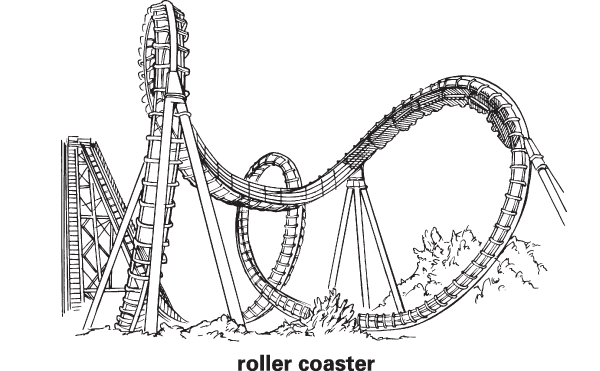Roller
Coasters & Energy!
click here to return
to the 8th Grade Science Directory / click
here to return to the Advanced 8th Grade Science Directory

INTRODUCTION
Warning! In order to complete this webquest, read EVERYTHING. If, after reading everything, you are still unclear about a step, see me. CLICK HERE TO DOWNLOAD THE PACKET.What's the best part of an amusement park? While some might say cotton candy, churros, or water rides, I believe the best part of amusement parks are the humongous roller coasters. The bigger the better!! Why Roller Coasters? Because they're awesome thrill-seeking, scream-provoking, vomit-inducing machines. Even though these rides feel dangerous, they're actually very safe inventions designed to feel as if you're breaking all rules of science. Are they? Of course not, physics plays a huge role in the design, motion, & fun of roller coasters.
Click here to watch "Build It Bigger: Kinetic Madness" What's your Dream Roller Coaster? Close your eyes & picture the amazing ride that awaits you. Draw a picture of your dream roller coaster. How many turns do you have? Any loops? Any major free falls? Corkscrews?
Part 1: Physics Research:
Before designing a roller coaster, you need to know the physics fundamentals.
Watch: The Future's Channel-
Roller Coasters: click here
Part A : Terms
to know
Remember
Newton's 2nd Law? ..Remember acceleration??
............................yeah....
that's what I thought.. :)
Define the following words. PUT in your own words, but
you can find the definitions here:
Acceleration: click here
Centripetal Force : click here
G (force) : click here
Newton’s 2nd Law : click here
Kinetic Energy (KE): click here
Potential Energy (PE) : click here

Watch the 2 BrainPops on Potential Energy (PE) & Kinetic Energy (KE ) and answer the questions in your packet. Log in instructions are on your handout
Watch the Eureka's on Potential Energy (PE) :click here & Kinetic Energy (KE ):click here
Watch "What is Potential & Kinetic Energy" click here and click here
Part
C : Roller Coaster Animations :
............................ Describe
2 of the 3 animations shown here
animation 1: click here .....animation 2: click here
..... animation 3: click here
Watch:
Time Warp: Roller Coaster Science: click
here
................................use the Blue Holt Book to answer the questions on your hand out

Part
E: What is Momentum?
1.
use
the Blue Holt Book to answer these questions on your handout
2. Go to : Physics4Kids: Momentum for information to answer the
.................................................
second half
of the questions:
click
here
Ever wonder where roller coasters were first created? Curious what the talest coaster in the world is?
Step: F: Answer these questions by visiting
the following sites:
Brittanica.com: click
here
Roller Coasters: Inventing the
Scream Machine Timeline: click
here
Roller Coaster Record Book: find the fastest/tallest/ etc: click
here
Amusement Park Physics: click here
Using the websites listed to the right, complete the data collection sheet to gather information regarding the types, heights, speeds, and lengths of roller coasters from various amusement parks.
Watch: How Roller Coasters Work: click here
Step:
G: ..Compare THESE Designs:
............-Six
Flags Magic Mountain Coasters: click
here
............-Cedar Point
(Ohio) Roller Coasters : click
here
............-King's Island (Ohio) Roller Coasters
: click
here
............Watch:
Roller Coaster Physics: click
here
............Watch: The Tallest Floorless Roller Coaster: click
here

......Roller Coaster Motion
Did
you know?? Roller coaster use an engine & cable
only at the first hill. After that, no more external
energy is added to it! That's amazing!
How does a roller coaster continue to move through the twists & turns of its track if it only uses an engine at the beginning?
Read: Physics4Kids: Motion & Energy: click here
Watch: How Roller Coasters Work: click here
..................Roller Coaster Energies: click here
...................Bill Nye on Energy: click here
There are many different elements of a roller coaste. Choose 4 of the "elements" list to the right and explain what they are, and what they do.
Step: I: Roller
Coaster Elements
Batwing ..... Butterfly Inversion ..... Camelback.... Cobra Roll....Corkscrew
.... Diving Loop ....
Hammerhead Turn .... Heartline Roll .... Horseshoe .... Immelmann Loop
.... Norwegian Loop ....
Pretzel Loop .... Raven Turn ....
Sea Serpent Roll .... Top Hat ..... Vertical Loop
use the sites listed below, or just "Google" the terms:
Wikipedia's Roller Coaster Thrill Elements: click here
Roller Coaster Database Glossary: click here
watch a video about a rollercoaster designer!
click here
Step: K: Build your roller coaster on line: click here / click here
Planning
Your classroom coaster: Think about what
part of the room you want to build your marble roller coaster in.
What kind of special features do you want? Hills? Loops? Corkscrews?
Your group will be provided with 6 foam insulation pipes and a roll
of masking tape. Jot down at least 5 of your ideas.